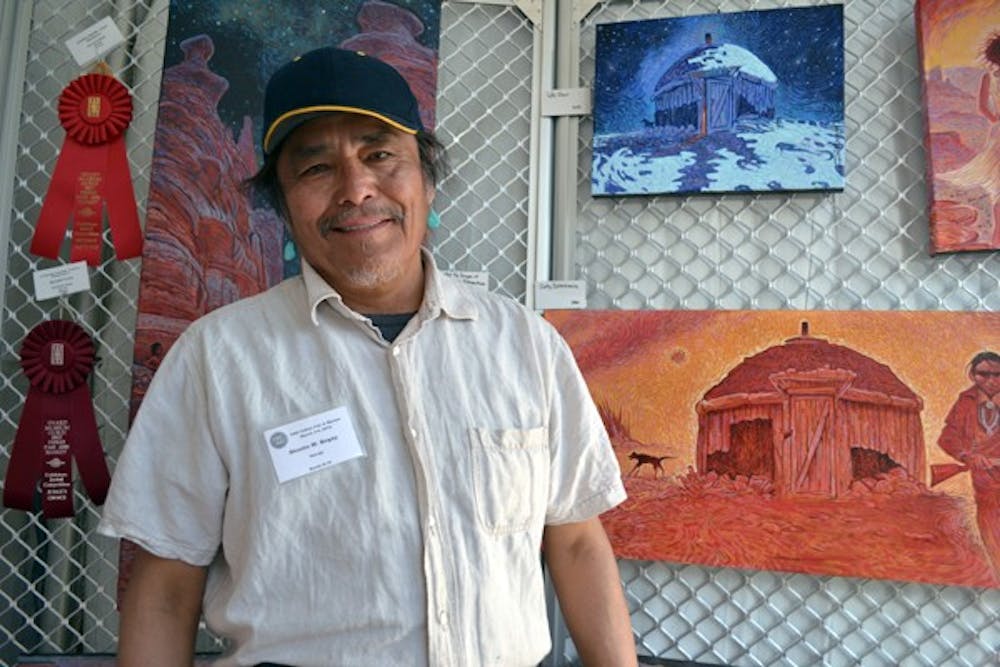Rich with tradition, spiritual displays and devoted customs, the 54th Annual Heard Museum Guild Indian Fair & Market provided an opportunity for cultural appreciation.
The festival in downtown Phoenix combined diverse Native American art and history with modern elements. The event overflowed with elderly tourists in sun hats and fanny packs. Adorned with their bright turquoise necklaces, earthy-toned earrings and traditional silver piece bracelets, it seemed that many winter visitors made sure to stop by the fair.
Among food demonstrations, soothing tribal music, jewelry sales, displays of bronze sculptures and thousands of intricate paintings and photographs, this event provided attendees with the unique chance to further their understanding of several native cultures.
Within each of several designated areas labeled “A-L,” hundreds of Native American artists set up booths for display. Each of the many tribes came to the festival equipped with representations of their centuries-old beliefs and creative demonstrations of modern tribal artwork.
Just beyond a sign marked "Area C," jeweler Royce “Eagle Boy” Kohlmeyer of the Jemez Pueblo tribe set up his elaborate display of award-winning turquoise and silver jewelry. Though not a miner, Kohlmeyer was well aware of the geological sciences of turquoise.
According to Kohlmeyer, the creation of turquoise takes millions of years and eventually forms as a gatherable deposit for use. Miners gather the ore, rocks that contain the mineral. Jewelers like Kohlmeyer buy the colorful material after it has been cut into cabochon as gemstones for their use.
Turquoise is among the most popular minerals found in Native American jewelry and brightly embodies extravagant green and blue colors with the occasional hints of earthy brown.
Located straight inside the festival’s entrance, artist Shonto W. Begay of the Navajo tribe sat humbly inside his artist tent for what he believed to be his sixteenth or seventeenth time.
Despite slight heat exhaustion, Begay was still engaged with his artwork and was content with being at the festival. He explained it is one of the chances he gets to socialize and reconnect with fellow artists and friends.
In what he called neo-impressionist art, the Navajo artist transcribes his dreams, nightmares, and visions of life into intricate paintings that spectacle several small brush strokes in a style similar to Claude Monet.
The colorful depictions of Native American women, landscapes and tribal men were not limited just to canvases. Begay believes that his artwork demonstrates his version of an unconventional reality.
He said, “Painting is as much holding back as it is applying.”
The artist also does Etch A Sketch artwork, twisting and turning the knobs of the old-fashioned toy to create spectacularly complex native designs of horses, men and women and much more inside the erasable sands of the screen.
Even though these Etch A Sketch creations can be destroyed, the story and tradition of the artwork at the festival cannot.
One of the most largely present tribes at the fair and market was the Hopi tribe. At the festival, the tribe presented their Hopi Cookbook Project in a demonstration under a small tent equipped with a small projector screen.
Hopi women, Iva Honyestewa and Jessica Quamahongnewa offered educational material and taste samples of a few of their traditional tribal meals as a part of their efforts to display and educate others about healthy Hopi dishes. Some of these dishes included noqkwivi which is comparable to a hominy stew and ongava pitsotiskwit enang which is a version of pork and beans.
Quamahongnewa mentioned amidst her presentation that their goal with their food demonstrations was to mix traditional Hopi life with modern life and spread the word about simple and nutritious Hopi dishes for anyone to enjoy.
Also scattered throughout the festival was the ever-popular and sweet-smelling fry bread that is associated with traditional Native American cultures, but has become somewhat mainstream. This light and flaky delicacy can be purchased at several events and venues throughout the U.S. and was appropriately offered at this tradition-filled festival.
While festivalgoers enjoyed their sweet and savory meals, they could also watch dancing and performances at the main stage amphitheater or at one of the smaller stages. Soothing tribal music provided a calm background noise for the busy fair.
Tony Duncan, Darrin Yazzie and Jeremy Dancing Bull of Estun-Bah performed at the Canyon Stage beside the food vendors during peak lunch hours. The group featured an uptempo Native American flute, guitar and percussion that combined traditional music with contemporary sounds.
Festivals like this one incorporate culture, creativity and genuine tradition. Appreciation for the beliefs and customs of Native American cultures allows for community enrichment as a whole.
Reach the reporter at ejnicho1@asu.edu
Click here to subscribe to the daily State Press newsletter.





